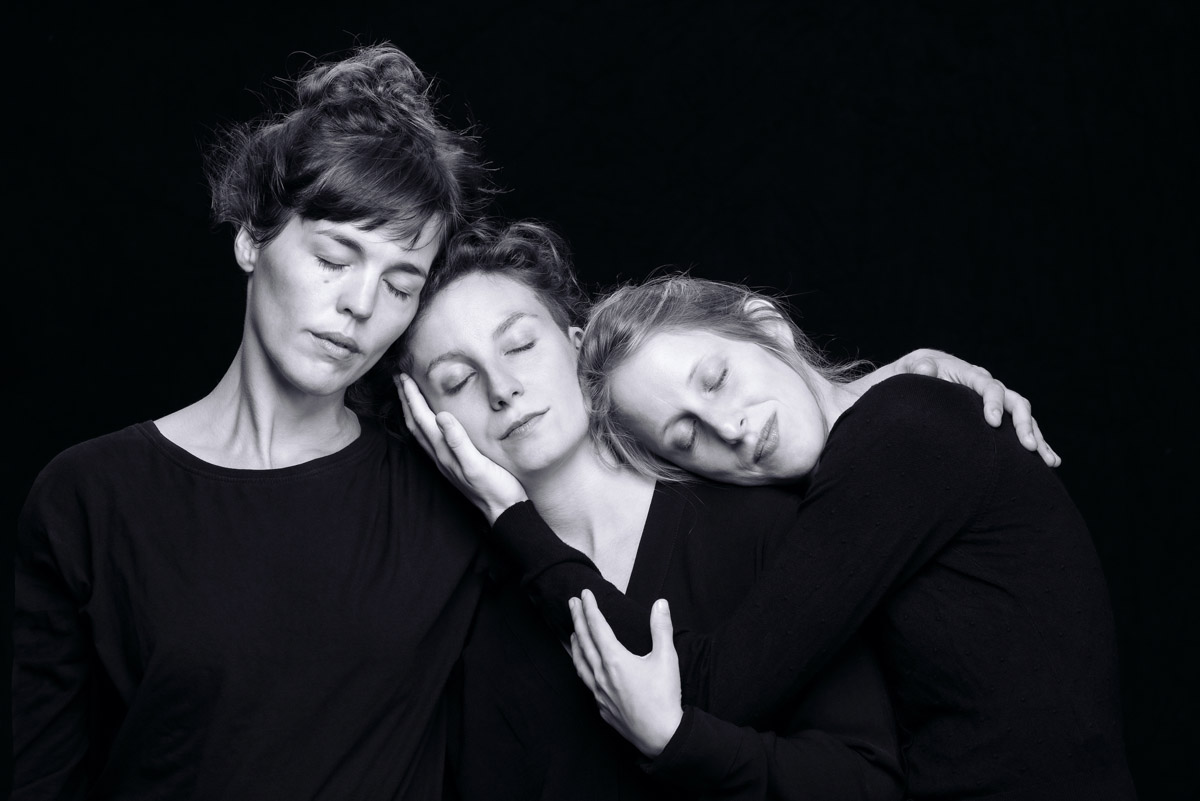PROGRAMME
One’s for sorrow, two’s for joy
m: David Dodds / t: trad. / a: The Unthanks & TRËİ
An old English nursery rhyme that tells of the art of ornithomancy (interpreting the flight of birds): the number of magpies – in many cultures a bird of (bad) luck – providing information about one’s fate.
The crow on the cradle
m & t: Sydney Bertram Carter (1915–2004) / a: TRËİ
British peace song from the 1960s that subtly carries the fear of nuclear war in the guise of a lullaby. Here, too, the crows predict the child’s future.
Ypne pou pairneis ta paidia
m & t: trad. / a: Christos Samaras
Greek lullaby from Thasos: “Sleep, take my child and give it back once it’s grown!”
The snow it melts the soonest
m: trad. / t: Thomas Doubleday (1790–1870)
English folk song, presumably from the year 1821, about saying goodbye to a loved one.
Devojko Mâri hubava
m & t: trad. / a: Kitka
A Bulgarian love song about an impossible love: the young girl has no dowry, and the young man has to go to war.
Wayfaring stranger
m & t: trad. / a: TRËİ
American folk and gospel song, presumably derived from a song by Isaac Niswander („Ich bin ja nur ein Gast auf Erden“, 1816): the lament of a soul facing death with confidence and hope.
Lullabies: Musa / Shlof, mayn feygele
m & t: trad. / a: TRËİ
Turkish lullaby / traditional Yiddish song of the Galician Jews from the 19th century.
Dorm Saurí
m & t: Mara Miribung (*1981)
Ladin (Rhaeto-Romanic) lullaby (2023). “Y sce al vëgn scür spo ascuta l’ vënt – l’ vënt sofla mia ciantia da te: And when it gets dark, then listen to the wind – it carries my song to you.”
Mo ghile mear
m: Domhnall Ó Buachalla & Dónal Ó Liatháin (1934–2008) / t: Seán “Clárach” Mac Domhnaill (1691–1754) / a: Gizem Şimşek
Irish Gaelic folk song to the people who were banished from their homeland.
Izgreyala e mesechinka
m & t: trad. / a: TRËİ
Bulgarian folk song about a girl picking flowers under the orange-coloured moon. The orange moon reminds her of sugar and honey.
Weavers
m: Abélia Nordmann (*1988) / t: Sarojini Naidu (1879–1949)
A short song which describes the eternal weaving of a newborn’s robes, a queen’s marriage veil and a dead man’s funeral shroud (2020). The lyrics were written by the Indian women’s rights activist Sarojini Naidu.
Mer tan itev
m & t: trad. / a: Zulal
An old Armenian circle chant from the area between Mount Arno and Mount Arto, south of Lake Van in Turkey. The song depicts a young man offering an apple as a symbol of love.
Dedidela
m & t: trad. / n: Abélia Nordmann
Traditional polyphonic singing from Georgia (region unknown) with the characteristic element of Georgian “yodelling” as an expression of great “joie de vivre”.
Prophetiae sibyllarum
m: Orlando di Lasso (1532–1594)
Prologue to the twelve motets by the Franco-Flemish composer Orlando di Lasso, who set the Sibylline prophecies to music: “These songs that you hear, sung in chromatic style, are those in which the [Sibyls/seers/prophetesses] once sang the secrets of salvation with a fearless mouth and confident voice.”
O, let me weep
m: Henry Purcell (1659–1695)
A fragment from the lament “The Plaint” from Purcell’s semi-opera “The Fairy Queen”.
Gesi baǧlari
m & t: trad.
Turkish lament about a young bride who has to leave her family and learns of her mother’s death far from home (1890).
Vísur vatnsenda – rósu
m: trad. / t: Rósa Gudmundsdóttir (1795 – 1855) / a: Jón Ásgeirsson (*1928)
Traditional Icelandic lullaby (1960) by the famous writer Rósa Gudmundsdóttir.
Bre, Petrunko
m & t: trad. / a: TRËİ
Bulgarian folk song about the Horo, a Bulgarian ring dance in which men and women join hands in a circle. It is sung in the West Bulgarian Šopi dialect.
El Cant de la Sibil·la
m & t: trad. / a: Maria Arnal, Marcel Bagés (2021)
The Song of the Sibyl, a chant still sung today in Catalan dialects in the Iberian region, goes back to Latin manuscripts from monastery libraries of the 10th century. These texts originated from the predictions of the Sibyls, the ancient pre-Christian seers. In the Middle Ages, the Sibyls were seen as the pagan counterpart to the prophets of the Old Testament and conveyed the word of the prophesying woman.
Performers:
Gizem Şimşek, Mara Miribung, Abélia Nordmann — concept, compositions, arrangements, vocals, cello, harmonium, psaltery

© Matthias Müller
TRËİ (Abélia Nordmann, Gizem Şimşek, Mara Miribung) performs vocal folk music from different cultures as well as their own compositions. Questioning the essence of what it means to be human is a theme carried throughout their music, both in staged concerts and interdisciplinary collaborations. The three women interweave their contrasting backgrounds and celebrate diversity in all its forms. TRËİ is based in Basel; the trio’s name comes from Ladin, a Rhaeto-Romanic minority language from the Italian Alps. trëi.com
THANKS TO
Schweizer Kulturstiftung Pro Helvetia, Abteilung Kultur Basel-Stadt, Stiftung Oertli and other foundations and supporters of this concert. We thank all women and girls who enriched our project with their thoughts and stories.
Tickets can be purchased from Monday, August 25, at the Kalamata Dance Megaron during the following hours:
18:00–20:00
For reservations, please call +30 698 472 8117 during the following hours:
10:00–12:00
Get the festival pass to attend all concerts:
€50 and €25 (reduced).
REDUCED ADMISSION FOR:
Students and people over 65 years of age.
FREE ADMISSION TO ALL CONCERTS:
Participants of the masterclasses, students of the Municipal Conservatory of Kalamata, as well as volunteers of the festival. Unemployed persons with a valid unemployment card. Disabled persons.




